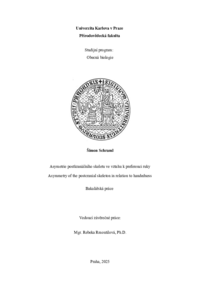Asymetrie postkraniálního skeletu ve vztahu k preferenci ruky
Asymmetry of the postcranial skeleton in relation to handedness
bakalářská práce (OBHÁJENO)

Zobrazit/
Trvalý odkaz
http://hdl.handle.net/20.500.11956/199371Identifikátory
SIS: 267243
Kolekce
- Kvalifikační práce [20861]
Autor
Vedoucí práce
Oponent práce
Struška, Michal
Fakulta / součást
Přírodovědecká fakulta
Obor
Biologie
Katedra / ústav / klinika
Katedra antropologie a genetiky člověka
Datum obhajoby
2. 6. 2025
Nakladatel
Univerzita Karlova, Přírodovědecká fakultaJazyk
Čeština
Známka
Dobře
Bilaterální asymetrie lidského těla představuje důležitý fenomén ovlivněný genetickými, biomechanickými a environmentálními faktory. Tato bakalářská práce se zaměřuje na asymetrii postkraniálního skeletu v souvislosti s dominancí ruky. V první části jsou shrnuty základní typy asymetrie - direkcionální asymetrie, antisymetrie a fluktuační asymetrie - a metody jejich studia, včetně tradičního měření, geometrické morfometrie, průřezové geometrie a analýzy entezálních změn. Druhá část práce hodnotí projevy asymetrie v horních a dolních končetinách, pánvi a páteři. Výsledky ukazují, že preference ruky se výrazně odráží v asymetrii horních končetin, kde dominantní strana vykazuje robustnější a odolnější struktury. Naopak u dolních končetin, pánve a páteře je vliv dominance ruky méně výrazný a asymetrie těchto struktur je určována především funkčními a vývojovými faktory. klíčová slova: bilaterální asymetrie, postkraniální skelet, dominance ruky, direkcionální asymetrie
Bilateral asymmetry of the human body represents an important phenomenon influenced by genetic, biomechanical, and environmental factors. This bachelor's thesis focuses on postcranial skeletal asymmetry in relation to handedness. The first part summarizes the main types of asymmetries-directional asymmetry, antisymmetry, and fluctuating asymmetry-and the methods used to study them, including traditional measurements, geometric morphometrics, cross-sectional geometry, and analysis of entheseal changes. The second part of the thesis evaluates the manifestations of asymmetry in the upper and lower limbs, pelvis, and spine. The findings show that handedness is strongly reflected in the asymmetry of the upper limbs, where the dominant side tends to exhibit more robust and resilient structures. In contrast, the lower limbs, pelvis, and spine are less influenced by handedness, and their asymmetries are mainly shaped by functional and developmental factors. The thesis highlights the importance of a complex approach when interpreting skeletal asymmetry, particularly for reconstructing the behavior and lifestyle of past populations. key words: bilateral asymmetry, postcranial skeleton, handedness, directional asymmetry
